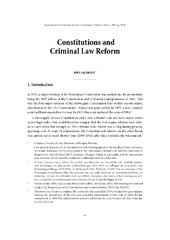| dc.contributor.author | Jacobsen, Jørn | |
| dc.date.accessioned | 2019-10-01T10:51:45Z | |
| dc.date.available | 2019-10-01T10:51:45Z | |
| dc.date.issued | 2017-12-23 | |
| dc.Published | Jacobsen J. Constitutions and Criminal Law Reform. Bergen Journal of Criminal Law & Criminal Justice. 2017;5(1):18-36. | eng |
| dc.identifier.issn | 1894-4183 | |
| dc.identifier.uri | https://hdl.handle.net/1956/20887 | |
| dc.description.abstract | In 2014, a major revision of the Norwegian Constitution was carried out, the momentum being the 200th jubilee of the Constitution and of Norway’s independence in 1814. This was the first major revision of the Norwegian Constitution (the world’s second oldest, only beaten by the US Constitution). Almost ten years earlier, in 2005, a new criminal code had been enacted in Norway. In 2015, this code replaced the code of 1902. A thoroughly revised Constitution and a new criminal code are both major events in any legal order. One could therefore imagine that the Norwegian reforms were related to each other, but wrongly so. This raises the questions: Should the Constitution have played a bigger role in the reform of the criminal code and in that case - how? And more generally: How could an optimal relation between a Constitution and a criminal law reform be achieved? | en_US |
| dc.language.iso | eng | eng |
| dc.publisher | The Faculty of Law, University of Bergen. | eng |
| dc.rights | Attribution CC BY | eng |
| dc.rights.uri | http://creativecommons.org/licenses/by/4.0/ | eng |
| dc.title | Constitutions and Criminal Law Reform | eng |
| dc.type | Journal article | |
| dc.type | Peer reviewed | |
| dc.date.updated | 2019-07-18T08:51:20Z | |
| dc.description.version | publishedVersion | |
| dc.rights.holder | Copyright 2017 Jørn Jacobsen | eng |
| dc.identifier.doi | https://doi.org/10.15845/bjclcj.v5i1.1351 | |
| dc.identifier.cristin | 1526367 | |
| dc.source.journal | Bergen Journal of Criminal Law & Criminal Justice | |

